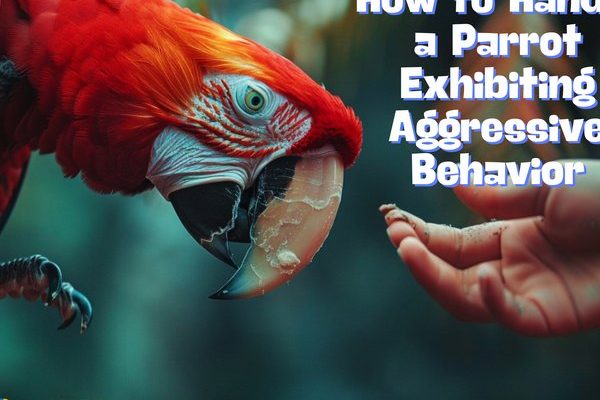
Think of your macaw as a complex puzzle. Each piece represents their personality, past experiences, and environment. To piece everything together and help them thrive, you need to approach their behavior with care and insight. This article will dive deep into understanding these beautiful creatures and provide practical tips for creating a safe, loving space for your feathered friend.
Understanding Macaw Behavior
Macaws are known for their intelligence and social nature. However, they can also become aggressive or fearful due to various factors. Understanding their behavior is the first step toward helping them feel more comfortable.
Aggression in macaws can stem from fear, territorial instincts, or hormonal changes. When a macaw feels threatened, they might puff up their feathers, squawk loudly, or even bite. It’s their way of saying, “Back off!” Recognizing these signs early can help prevent escalation. Similarly, fear can manifest as hiding, screaming, or trying to escape. Assessing the situation calmly can help you figure out the root cause of their behavior.
Think about a time when you felt scared or defensive. Maybe it was a new job or moving to a new place. Sometimes, we just need a little reassurance. For macaws, understanding their triggers often involves observing their body language and responding with patience.
Creating a Safe Environment
The environment you provide plays a huge role in how your macaw behaves. Think of it as their safe haven. If they feel secure in their surroundings, they’re more likely to act naturally and with less aggression.
Start by setting up their cage with plenty of toys and perches. This isn’t just about entertainment; it also gives them space to explore and play, which reduces boredom. Ensure their cage is in a quiet area of your home where they can feel safe but still be part of family life. Consistency is key here; a stable environment helps macaws thrive.
Also, consider the materials in their environment. Some macaws might have preferences for certain textures or colors, and providing familiar toys can help reduce their fear. It’s all about trial and error—don’t hesitate to experiment to see what comforts your bird.
Building Trust Through Positive Reinforcement
Trust is the cornerstone of any relationship, including the one you have with your macaw. To gain their trust, positive reinforcement is your best friend. This involves rewarding your macaw for desirable behaviors rather than punishing them for bad ones.
Start with small steps. For instance, if your macaw approaches you without showing signs of aggression, offer a treat or praise. You might say, “Good job!” in a cheerful tone. Over time, they’ll begin to associate you with positive experiences. This gradual approach helps reduce their fear and helps them feel more secure around you.
Remember, patience is crucial here. Building trust won’t happen overnight, and that’s okay. Celebrate the little victories, like your macaw taking a step closer to you. Each positive experience strengthens your bond and builds their confidence.
Identifying Triggers and Avoiding Stressful Situations
Just like us, macaws have specific things that make them feel anxious or scared. Identifying these triggers is an essential part of helping your macaw feel more secure. Common triggers might include loud noises, sudden movements, or even certain people.
Keep a diary of your macaw’s behavior to pinpoint when they act fearful or aggressive. Are there specific times of day when they’re more aggressive? Do certain visitors cause them to act up? Understanding their unique triggers can help you adjust their environment or approach.
Once you have an idea of what stresses them out, take steps to minimize these situations. If they’re scared of loud noises, for example, try to keep background noise down. This small change can have a significant impact on their mood.
Introducing Socializing and Handling Techniques
Once you’ve established trust and created a safe environment, it’s time to introduce socializing and handling techniques. Start slowly and gradually increase the level of interaction.
Let your macaw come to you on their terms. You might sit next to their cage and talk to them softly at first. Allow them to approach when they feel ready. This respects their comfort level and encourages them to explore without pushing them into alarming situations.
When they seem ready, start with gentle handling. Place your hand near their perch and encourage them to step up. If they hesitate or get aggressive, don’t force it. Instead, back off and try again later. Using treats to encourage stepping up can also help. Just ensure your hands are steady—quick movements can trigger fear.
When to Seek Professional Help
Sometimes, despite your best efforts, your macaw may still struggle with aggression or fear. If their behavior doesn’t improve or worsens, seeking professional help might be the next step.
Consider reaching out to an avian veterinarian or a certified animal behaviorist. They can provide insights and tailored solutions based on your macaw’s individual needs. Professional guidance can be invaluable, especially if you’re unsure how to proceed.
Don’t feel discouraged; reaching out for help is a sign of a dedicated caregiver. Just like with any pet, some behaviors may require expert knowledge and tools to overcome.
Handling aggressive or fearful macaws isn’t a walk in the park, but with patience and understanding, you can help transform their behavior. Remember, these colorful creatures are more than just pets; they’re individuals with unique personalities and histories.
By creating a safe environment, building trust through positive reinforcement, and addressing their triggers, you’ll start to see improvements over time. And if you ever feel overwhelmed, don’t hesitate to reach out for professional assistance. In the end, it’s all about building a strong, loving bond with your magnificent macaw. So pop that kettle on, pour yourself a cup of coffee, and enjoy the journey!

